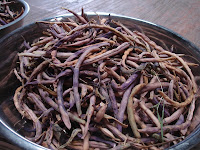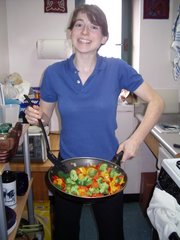
We had a chance to visit Mark Shepard's permaculture shire (oh okay, "perennial agricultural ecosystem", according to
this bio) in southwestern Wisconsin last week. I won't get into the awesome awesomeness that was Mark and his farm, but I will post some hazelnut photos...
In the U.S. we use the term
hazelnut and
filbert interchangeably, while in Europe
filbert only refers to varieties of
Corylus where the husk is longer than the nut. The "hazel" comes from the Anglo-Saxon
haesel, which means headdress or bonnet (referring to the outer shell's shape). The "filbert"? Some think the term comes from the German
vollbart, meaning full beard, also a reference to the husked shell, but the most commonly heard explanation is that hazelnuts mature around St. Philibert's Day, August 20.

According to
"Permaculture Plants", hazelnuts begin bearing at 4 years of age, and can live fifty years or more. Their flowers can survive temperatures slightly below zero (-20 degrees C), and they have the potential to produce over 30 pounds of nuts per tree (though in the midwest, sans pruning or any cultivation, i think 5-8 pounds was cited as a good go). Great source of protein and oil (think of how great a hazelnut biodiesel tractor would smell--although maybe the alcohol component would neutralize the oil's aroma? Any chemistry majors in the house?).
Due to the high percentage of oils in hazelnuts they aren't storage hardy. Shell on,

you could get four months in the fridge (one month at room temp). If your hazelnuts rattle in their shell when they're shaken, they've lost water moisture and are probably not so great anymore.
For more on permaculture goodness, check out
Midwest Permaculture or the
Permaculture Research Institute. For filbert cooking tips, check out about.com's
hazelnut cooking page.
 Had the chance to accompany Tim Huth of Lotfotl Community Farm fame** to his weekend farmer's market in Milwaukee. Just wanted to post some pics of his pretty produce and throw up some links.
Had the chance to accompany Tim Huth of Lotfotl Community Farm fame** to his weekend farmer's market in Milwaukee. Just wanted to post some pics of his pretty produce and throw up some links. 


























